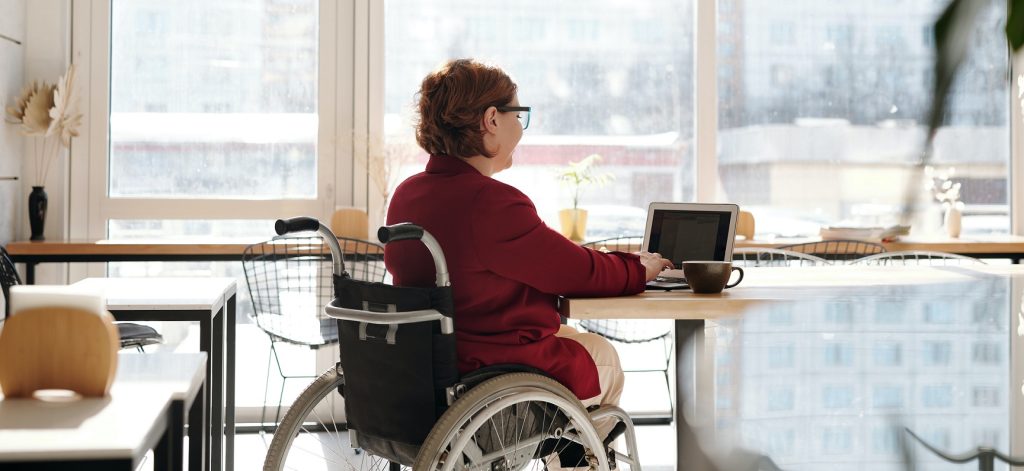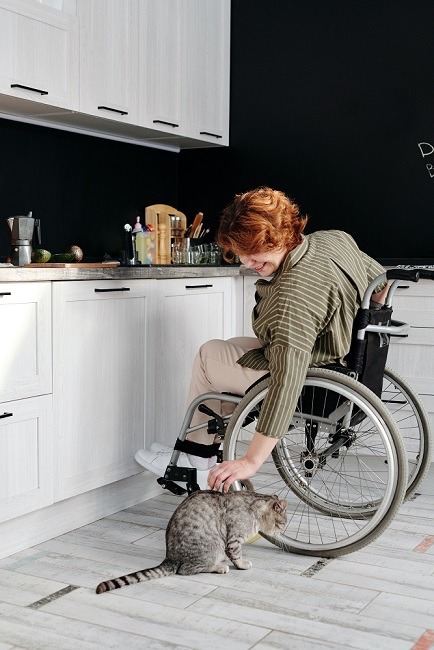
The internet and the smartphone help with all kinds of tasks. But can technology support accessibility at home?
Property-related technology, or proptech, can indeed.
To start, tech innovations can make housing safer. They can monitor and improve indoor air quality. They can warn us about potential outages of basic systems in our homes. Smart tech can help people with audio or visual disabilities do more — or do it more easily — at home.
There’s so much innovation happening. We’ll take a look at just a few examples here.
Real Estate Professionals Make Their Websites Accessible
For people with sight or hearing challenges, real estate professionals are adopting accessibility standards. A leading example is the WCAG — the Web Content Accessibility Guidelines. WCAG is really a set of best practices for internet design. The guidelines include placing transcripts with videos and online tours, and enabling closed captioning for audio-visual content. (People now expect to find video tours of real estate for sale. If a video tour is there, it’ll pay off, according to a Hubspot survey.)
Real estate exemplifies the way our modern life is becoming tech-enabled. Certainly the pandemic boosted the real estate and title sector’s adoption of proptech. In 2020, agents learned how properties could be shown, leased, and even purchased online.
And now, many new technologies are practically taken for granted. Nuveen, a money management firm for nonprofit institutions, sums it up this way:
New technologies that are in various stages of adoption – think blockchain, the metaverse and autonomous vehicles – will significantly impact the (not so distant) future of real estate. While these technologies may be years away from going mainstream, real estate practitioners should understand their future significance…
An interesting forecast. But relevant to accessibility? It is. The tech Nuveen mentions will offer people new forms of mobility, and new ways of enjoying optimized experiences at home.
Now, here are some of the smart tech offerings that are already making home life easier.
Smart Homes Become More Accessible

Everyday tasks can present hassles for people living with disabilities. Depending on the challenges a person faces, tech like Apple’s HomeKit and other smart-home systems can be game-changers. Smart-home devices running on a good Wi-Fi network can support independent living at home.
Turn on lights without having to touch a switch; talk with someone at door without approaching it; turn on the fan with a simple voice command or by touching an iPad. An app known as VoiceITT can support voice commands from people with nonstandard speech patterns.
The New York Times product test column “Wirecutter” also points to these smart-home innovations:
- Amazon’s Alexa has Routines. This is notable because it can make a smart doorbell turn on a smart bulb to shine a specific hue of light, creating signals for those who don’t hear.
- Unsighted or partially sighted people can use Amazon’s Echo Show, together with Alexa, to identify the objects they hold up.
- Smart plugs like Wemo or Wyze let people remotely turn things on or off, put them on timers, or link them to sensors that light up rooms when a person approaches. Smart plugs can automate fans, coffee makers — basically, anything at all that plugs in.
- Smart thermostats can now help adjust the whole home as desired, or automatically adjust the temperature when someone’s home. They can even let trusted people change room temperatures from another location. Smart blinds or shades can be timed, too.
- Keyless smart locks work through voice or touch, and can lock up when someone’s home, or when another home feature turns on or off. Smart doors are remote-controllable. Motion sensors can detect the movements of house doors — and even the doors on fridges and cabinets.
- Smart smoke detectors can send phone alerts, and turn on the lights automatically. They can also be turned off without making anyone try to reach the ceiling.
- Security apps now offer access to emergency responders. And they enable communication when someone responds and walks up to the home.
These technologies work with a smartphone, with apps, and a home internet system. Set-up help may be necessary.
Tech-Savvy NYC Focuses on Benefits for Its Apartments
For some people, a smart home can save a lot of money that would have been spent on frequent caregiver visits. With this reality in mind, New York City is promoting innovations in technology to support its residents’ lives at home.
The New York City Economic Development Corporation aims to “enable underserved communities throughout the City to enjoy the same benefits that residents of luxury buildings have long had access to.” For starters, property tech can raise the quality of NYC residential life by predicting and preventing outages, alerting technicians to elevator malfunctions, and spotting hazards in City buildings.
The City’s Proptech Piloting Program sets out to help train a new generation for proptech careers, support pilot programs for their innovations, and zero on which innovations the City’s residents need most.
One of the NYC Economic Development Corporation’s agency partners is the New York City Housing Authority. Its mission is to help NYC residents with modest incomes get housing. The scope of this agency is impressive: it’s home to one in every 15 New York City residents. Nearly 12% of NYC rental units are part of it.
To support these residents, NYCEDC says it’s especially keen on working with startups that create accessibility or environmental improvements, or both.
OK, So What About Help With the Technology Itself?
The path to having a tech-enabled home in the first place presents its own set of challenges.
The Philly-based SunKirb Ideas group identifies itself with a helpful motto: “Everyday things working smarter for you!” Sunkirb offers advise on how to navigate day-to-day home life, supported by technology. In short, the service supports people whose quality of life can benefit from smart devices and products.
To help people plan, adopt, and become expert users of smart-home tech, there’s also the Pennsylvania Assistive Technology Foundation. The PATF offers a “Smart Homes Made Simple” concept. Part of this is a publication titled Smart Homes Made Simple: Your Guide to Smart Home Technology. As the PATF explains:
We hope this guide will empower you to explore the most current smart home technology, develop a framework to choose your technology, and build a team who can support you in achieving your goals.
There are also a number of commercial options for local installation and user support. Wirecutter gives the example of Best Buy’s Geek Squad. Best Buy sells all sorts of smart devices, and can install them and show their owners how to work with them at home.
While we’re not here to endorse any products, stores, or services, we do hope this article offers you some practical ideas for you or your loved ones. It’s clear that homes can be made more accessible with some innovations currently available. And judging by New York City, assistance might be on the way for the large population of people with disabilities, or a desire to age in place.
Supporting References
Rachel Cericola, for Wirecutter, Inc., A New York Times Company: These Smart Home Devices Can Enhance Independence for People With Disabilities and Mobility Needs (updated Apr. 29, 2022).
Matt Weirich for Forbes.com: Real Estate – How to Leverage Proptech to Advance Your Property’s Digital Accessibility (May 27, 2021).
Jeanne Casey for Nuveen, LLC: How Consumer Behaviour Is Driving Change in Proptech (Jul. 6, 2022).
New York City Proptech Piloting Program – Participating Agency Partners Portfolio Overview (PDF).
And as linked.
Photo credits: Marcus Aurelius, via Pexels.
